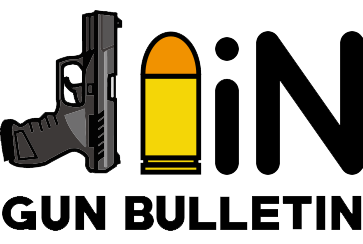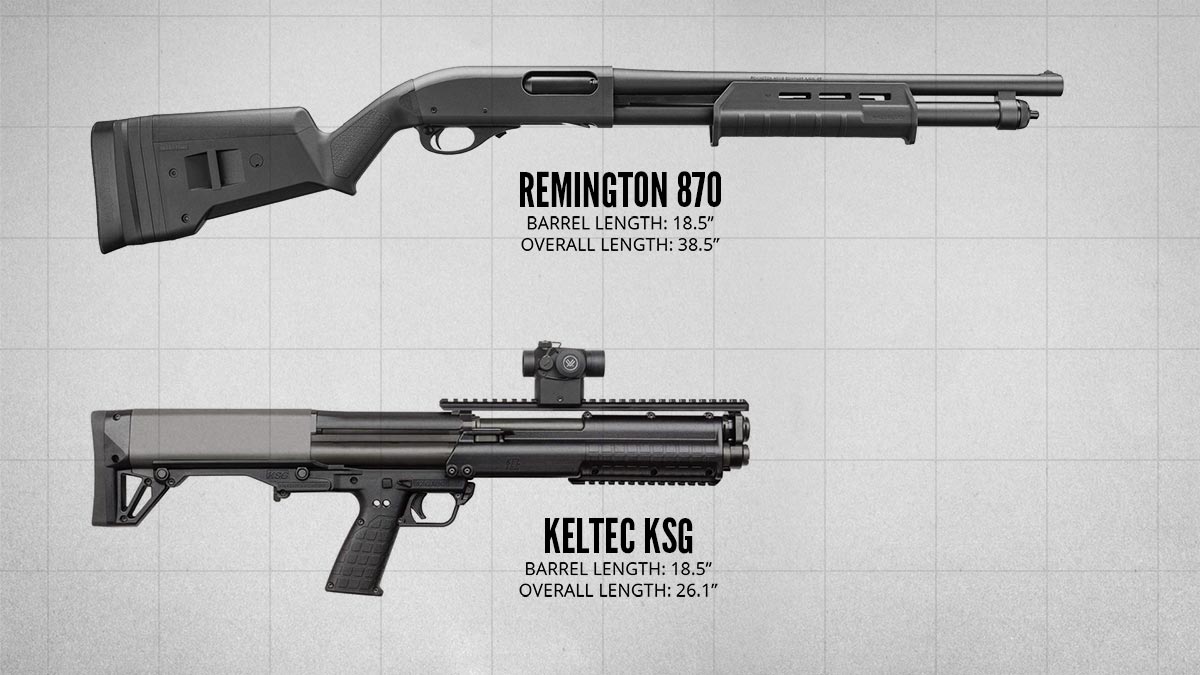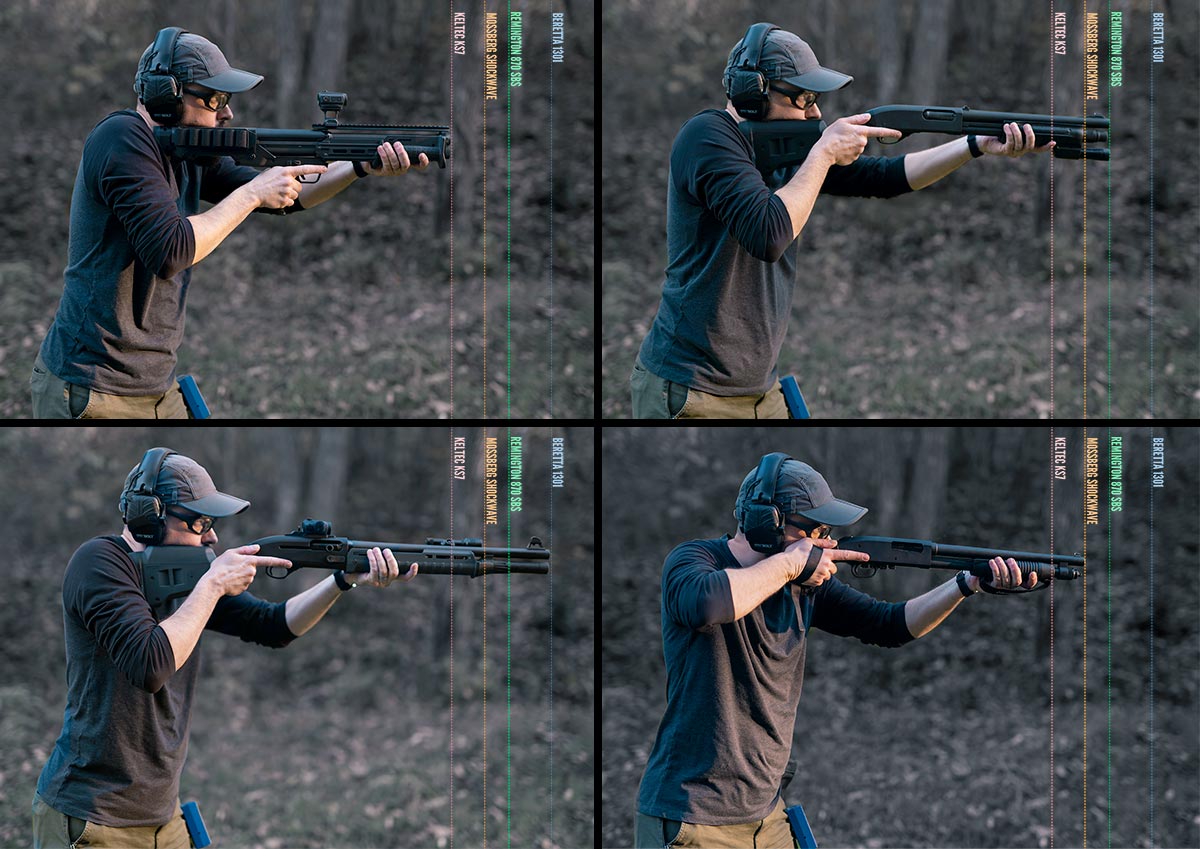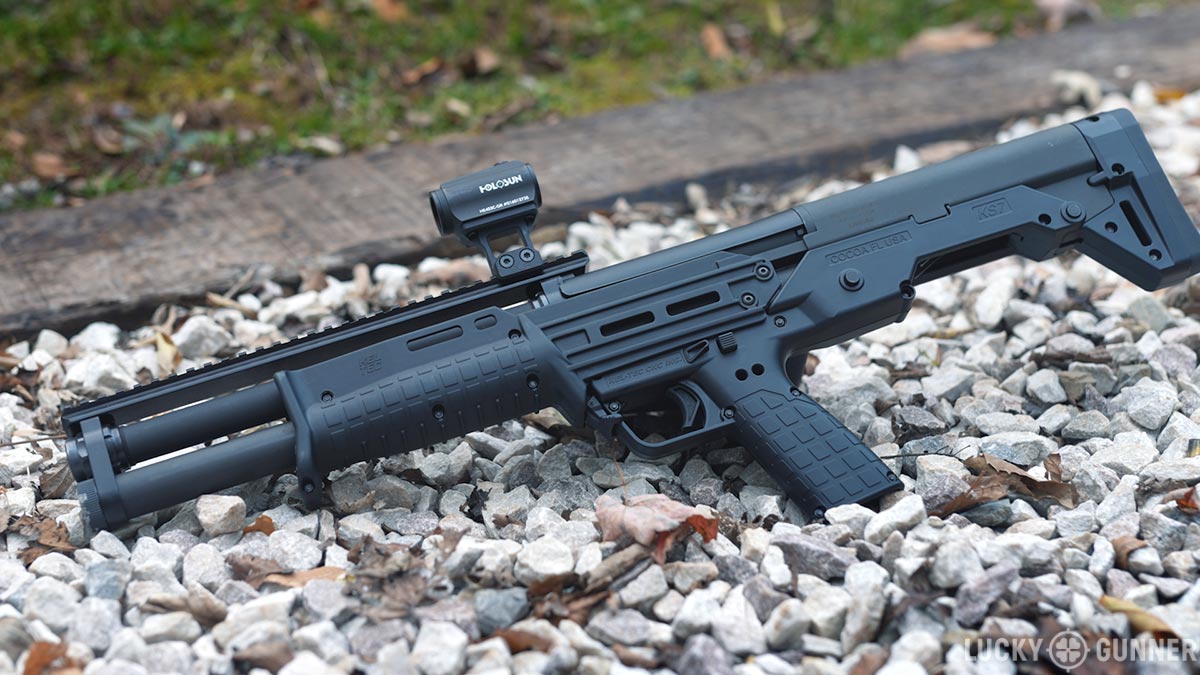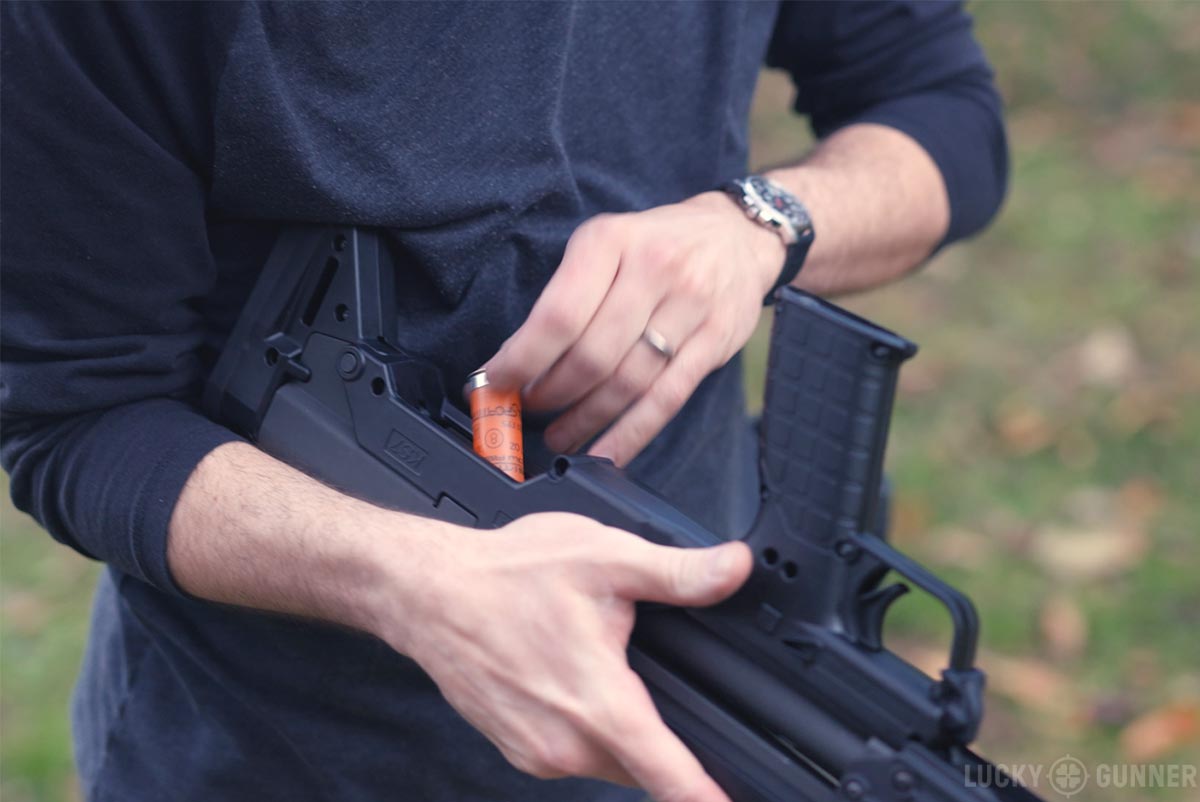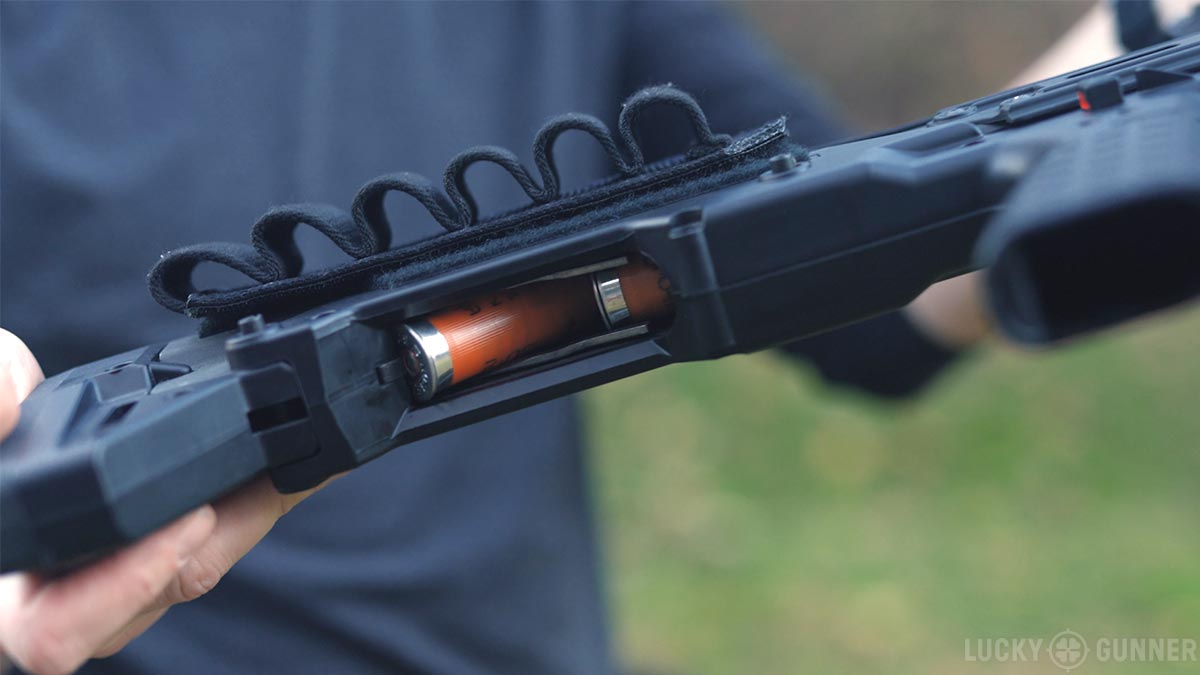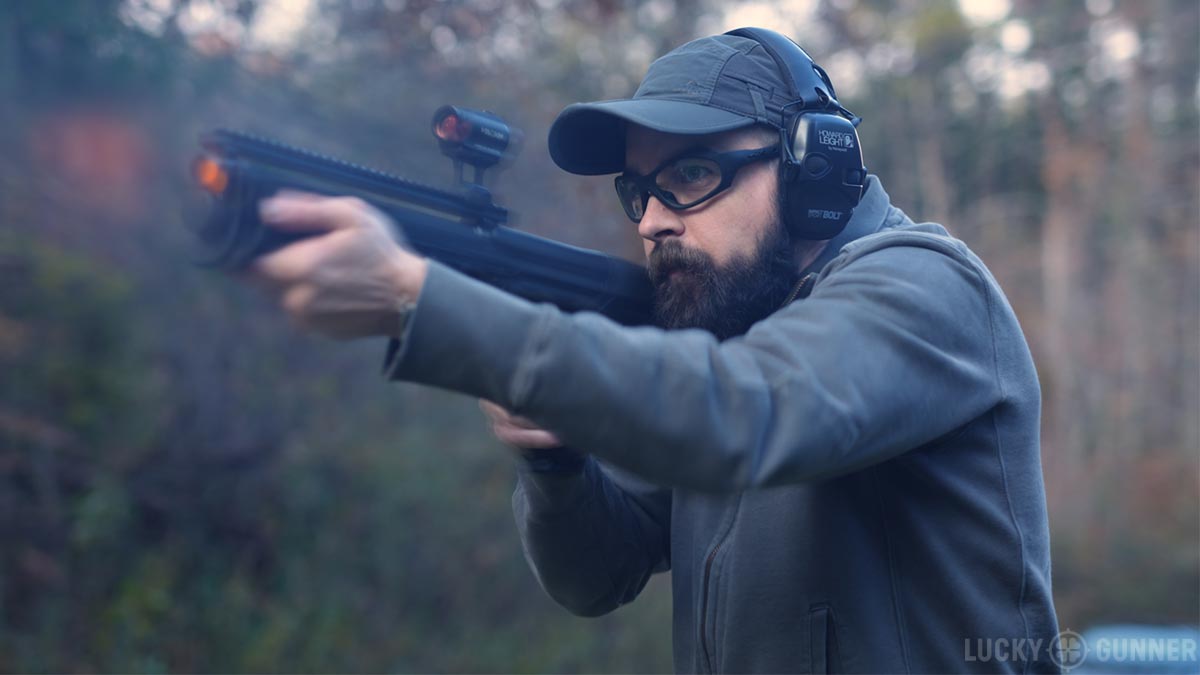With the release of the Smith & Wesson M&P12 earlier this year, it looks like bullpup shotguns are finally making their way into the mainstream. Is it a viable concept for home defense with legitimate benefits over conventional shotguns, or just a passing fad that will become meme-fodder in a few years?
Using the KelTec KS7 as a test platform (with the hope of side-stepping the mechanical complexity issues of the multi-tube models), we try to examine some of the pros and cons inherent to shotguns with a bullup configuration.
Details are in the video below, or scroll down to read the full transcript.
Is the bullpup shotgun a great idea that’s been a long time coming or just a gimmick? Maybe somewhere in between? Hey everybody, I am Chris Baker from LuckyGunner.com and that’s what I’ve been exploring the last couple of weeks. I still don’t have a solid answer, but I do have a few thoughts about bullpup shotguns that I want to share today.
Bullpup Shotguns: History and Purpose
The idea of the bullpup-style shotgun is not new. There have been a few attempts going back to at least the 1980s. But it’s only been about 10 years since KelTec released the KSG, which is the first commercially successful bullpup shotgun. Several other companies have followed Kel-Tec into the bullpup shotgun market and now we have more than a dozen options to choose from. Most of those options are from somewhat obscure or less well-known gun makers with the exception of Smith & Wesson. They released the M&P12 earlier this year.
Most bullpup shotguns are designed with self-defense in mind. For defense inside a home, the length of a conventional shotgun is often considered one of its biggest drawbacks. The primary purpose of a bullpup design is to make the gun shorter without sacrificing barrel length. Both of these shotguns have 18.5-inch barrels. But with the action located behind the trigger, the bullpup is a foot shorter overall.
This KelTec KS7 is seven inches shorter than my registered short-barreled Remington 870. 11 inches shorter than my beloved Beretta 1301. It has the same overall length as a Mossberg Shockwave. If you actually aim the Shockwave with the cheek weld technique, it sticks out a couple of inches more than the bullpup. So the length advantage of the bullpup is really unmatched in the shotgun world.
Side Benefit: Increased Ammo Capacity
The other big feature that has drawn shooters to the KSG specifically is the dual magazine tubes. Each tube can hold seven 2 ¾-inch shells plus one in the chamber for a total capacity of fifteen rounds. KelTec is actually not the pioneer of this concept. In the 1990s, the NeoStead 2000 bullpup shotgun from South Africa also had dual magazine tubes. Internally, the two guns are nothing alike, but it’s interesting to see KelTec bring back that feature.
And they’re not the only ones. Modern competitors to the KSG like the UTS-15 and the M&P12 utilize dual mag tube designs as well. The Standard Manufacturing DP-12 has two tubes and two barrels. And there’s the Tavor TS12 semi-auto bullpup with three 5-shot tubes.
Also, within the last couple of years, we’ve started seeing a ton of different shotguns imported from Turkey, including several semi-auto and pump action bullpups that feed from detachable box magazines.
Just ten years ago, we had a defensive shotgun market that was completely dominated by conventional designs that were essentially modified sporting shotguns. Many of those designs were several decades old. Today we’ve got a variety of new options — ultra compact shotguns with twice the ammo capacity of the old models. Guns that were designed from the ground up for the mission of personal protection. As a fan of shotguns, it’s very exciting to finally see some genuine attempts at innovation.
Mechanical Complexity
But I’m not quite ready to jump on the bullpup bandwagon just yet. The benefits come with some trade-offs. For the models with multiple mag tubes, the big trade-off seems to be mechanical complexity. That doesn’t necessarily mean they’re inherently less reliable, but there are more potential points of failure — both mechanical failure and operator error. The user has to learn a few extra steps to keep the gun running. The loading process is more complicated, and some of the designs require the user to manually switch tubes when one runs empty.
I don’t know if any of that’s a deal breaker. It kind of depends on how much you value extra ammo capacity in a defensive shotgun. I don’t consider it a high priority. A single round of buckshot is generally all it takes to provoke an immediate change of behavior in a violent threat. Occasionally it takes two, if you’re really unlucky. I can’t fault anyone for wanting greater ammo capacity than what you get from a standard five to seven shot tube. Modern pistols and rifles have trained us to expect double digit capacity. But with a shotgun, I’m okay with a lot less than that.
The KelTec KS7
That’s one of the reasons I decided to start my bullpup shotgun experiment with the KelTec KS7. This is essentially the single tube version of the KSG, so it’s got a 7+1 capacity. It’s also a full pound lighter than the KSG and costs about a third less with an MSRP of $580.
Another feature that drew me to the KS7 is the built-in handstop on the forend. This helps keep your hand from slipping off and in front of the muzzle. The KSG and most of the other pump action bullpups instead have the option to add a vertical foregrip to mitigate that issue. I would much prefer to use a standard horizontal grip on the forend and the KS7 lets me do that while still providing some protection from self-amputation.
Like we’ve come to expect from KelTec, the KS7 has some quirks in its design and execution. For instance, the crossbolt safety works in the reverse direction of every other crossbolt safety I’ve used. So I’m not going to cover every little issue I’ve had with this gun. I didn’t set out to review the KS7 specifically. My goal for now is to just learn what I can about bullpup shotguns in general.
Challenges of Using a Bullpup Shotgun
So let’s go back to the issue of trade-offs. I’m not thrilled with the tradeoffs necessary to get extra ammo capacity. But what compromises might be necessary to get the shorter length? Are there some shortcomings inherent to the bullpup configuration itself?
On my first range trip with the KS7, the only thing I really learned is that this gun has absolutely brutal recoil. With my Beretta or my 870, I can shoot six hundred rounds in a weekend and my shoulder is always just fine at the end of it. I got through half a box of shells with the KS7 and I was done for the day.
Part of that is because this is just a light shotgun. It weighs 5.9 pounds unloaded. But I’ve shot other pump actions that didn’t weigh much more than six pounds, and they were not quite as unpleasant to shoot.
I think there’s some other stuff going on with the ergonomics here. The buttstock has a small surface area, so the felt recoil is more concentrated. The comb of the stock is in line with the bore and that made it difficult to get a cheek weld and keep the stock off my collar bone. That is why I replaced the original carry handle sight with a picatinny rail and an optic on a tall 1.93-inch mount. I wouldn’t say the gun is fun to shoot now, but it’s much more tolerable.
I don’t know if recoil is quite as much of an issue with other bullpup designs. But they do all have stocks that are directly in line with the bore. That means, just like with an AR-15, the ideal height for the optic is an important detail to figure out and it might vary from person to person. It’s also worth pointing out that there’s not really any way to shorten the length of pull with a bullpup. That’s something we can do with a conventional shotgun that can dramatically help with recoil management. It’s not really an option with these guns.
Another issue is access to the action. Most, but not all bullpups eject from the bottom behind the pistol grip. That’s your only access to the chamber or the mag tube. If you want to do a chamber check, clear a malfunction, or emergency load the chamber, you pretty much have to flip the gun upside down.
With a little practice, I got okay at reloading the KS7. I ran the reload stage of the shotgun skills test that I posted a few months ago. I can usually do that stage in a little over eight seconds. With the KS7, I managed 8.8, which is a lot better than I was expecting. I stuck some velcro tape to the right side of the stock/receiver and attached a Vang Comp shell card. That setup worked out pretty well.
The trend here so far is that a lot of the challenges of using a bullpup are not necessarily insurmountable, they’re just weird. They take a little work to overcome by figuring out some new techniques or tweaking how the gun is set up.
It’s Not You, It’s Me… Maybe
Another one of those challenges I ran into with the KS7 is cycling the action. I’ve encountered all kinds of feeding issues, but usually just when I’m trying to run the action quickly. On the KS7, my support hand is about four inches closer to the trigger guard than it is with a Remington or a Mossberg pump. It’s also not an especially smooth action. So it just feels a lot different than what I’m used to.
If I try to run the KS7 as fast as I run my 870, I get failures to feed, double feeds, and live rounds dumped on the ground. That could be KelTec being KelTec, or it could just come down to operator error. Either way, it tends to run fine if I go a bit slower.
It turns out that having past experience with pump action shotguns is not always a good thing with the KS7. It’s a lot of stuff to re-learn. Even when I try to look at this through the eyes of a novice, it seems like a bullpup design would have a steeper learning curve than a conventional shotgun, but I have to admit to some bias there. Is all of that worth the advantage of having a much shorter gun?
The Length Advantage in Context
Using a long gun inside around furniture and doorways is a pain. But, as we’ve discussed here many times before, in case of an actual home invasion, it’s generally a good idea to just stay put and wait for them to come to you rather than try to be a one-man SWAT team. If you’re bunkered in place, a conventional 18-inch shotgun is probably not a major disadvantage.
But you might have kids in the house that you have to get to. Depending on how your house is laid out, you might have some tight spaces to work around, even if you never leave your bedroom. The utility of a shorter shotgun is really based on the situation, the environment, and the ability of the user.
If we need to drastically shorten a conventional shotgun just temporarily while we move through a doorway or something, we can use the short stocking technique that I’ve talked about before, or an under the armpit technique. Short stocking with a 14-inch 870 gives me a profile that’s as long as shouldering the KS7, but that comes at the expense of reduced recoil control and reduced accuracy beyond a few feet.
Despite the major length advantage, I still don’t like the compromises I would have to make to become a dedicated KS7 user. So if I keep this project going, my next step will be to try a different bullpup shotgun. Probably a semi-auto, but I’m open to other ideas.
If you guys want me to continue to explore the potential of bullpup shotguns, let me know in the comments. Depending on the response, I’ll try to tackle that in the first half of next year. For now, if you found that helpful and you want to show us your support, be sure to buy some ammo with lightning fast shipping from us at LuckyGunner.com.
The post The Bullpup Shotgun Experiment appeared first on Lucky Gunner Lounge.
